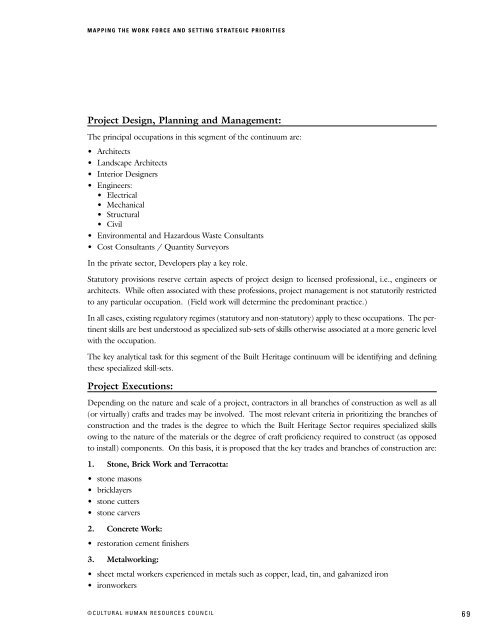Human Resources in Canada's Built Heritage Sector: Mapping the ...
Human Resources in Canada's Built Heritage Sector: Mapping the ...
Human Resources in Canada's Built Heritage Sector: Mapping the ...
- No tags were found...
You also want an ePaper? Increase the reach of your titles
YUMPU automatically turns print PDFs into web optimized ePapers that Google loves.
MAPPING THE WORK FORCE AND SETTING STRATEGIC PRIORITIESProject Design, Plann<strong>in</strong>g and Management:The pr<strong>in</strong>cipal occupations <strong>in</strong> this segment of <strong>the</strong> cont<strong>in</strong>uum are:• Architects• Landscape Architects• Interior Designers• Eng<strong>in</strong>eers:• Electrical• Mechanical• Structural• Civil• Environmental and Hazardous Waste Consultants• Cost Consultants / Quantity SurveyorsIn <strong>the</strong> private sector, Developers play a key role.Statutory provisions reserve certa<strong>in</strong> aspects of project design to licensed professional, i.e., eng<strong>in</strong>eers orarchitects. While often associated with <strong>the</strong>se professions, project management is not statutorily restrictedto any particular occupation. (Field work will determ<strong>in</strong>e <strong>the</strong> predom<strong>in</strong>ant practice.)In all cases, exist<strong>in</strong>g regulatory regimes (statutory and non-statutory) apply to <strong>the</strong>se occupations. The pert<strong>in</strong>entskills are best understood as specialized sub-sets of skills o<strong>the</strong>rwise associated at a more generic levelwith <strong>the</strong> occupation.The key analytical task for this segment of <strong>the</strong> <strong>Built</strong> <strong>Heritage</strong> cont<strong>in</strong>uum will be identify<strong>in</strong>g and def<strong>in</strong><strong>in</strong>g<strong>the</strong>se specialized skill-sets.Project Executions:Depend<strong>in</strong>g on <strong>the</strong> nature and scale of a project, contractors <strong>in</strong> all branches of construction as well as all(or virtually) crafts and trades may be <strong>in</strong>volved. The most relevant criteria <strong>in</strong> prioritiz<strong>in</strong>g <strong>the</strong> branches ofconstruction and <strong>the</strong> trades is <strong>the</strong> degree to which <strong>the</strong> <strong>Built</strong> <strong>Heritage</strong> <strong>Sector</strong> requires specialized skillsow<strong>in</strong>g to <strong>the</strong> nature of <strong>the</strong> materials or <strong>the</strong> degree of craft proficiency required to construct (as opposedto <strong>in</strong>stall) components. On this basis, it is proposed that <strong>the</strong> key trades and branches of construction are:1. Stone, Brick Work and Terracotta:• stone masons• bricklayers• stone cutters• stone carvers2. Concrete Work:• restoration cement f<strong>in</strong>ishers3. Metalwork<strong>in</strong>g:• sheet metal workers experienced <strong>in</strong> metals such as copper, lead, t<strong>in</strong>, and galvanized iron• ironworkers©CULTURAL HUMAN RESOURCES COUNCIL69










